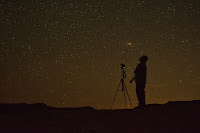Introduction and Monthly Reminders
April was off to an excellent start for astronomers. I could easily view and image the Moon and the Sun, with many sunspots. Watching Mars form a line with the bright stars Castor and Pollux in Gemini was a joy. I could even watch the ISS pass by overhead, a sight I hadn't seen in a while. Venus was easy to find in the morning sky before sunrise, but I have yet to see Mercury and Saturn.
On the 22nd, observers can still catch the peak of the Lyrid Meteor Shower. Venus and Saturn can be seen close by shortly before sunrise on the 28th. Venus will reach its greatest brilliance on the 27th, shining at magnitude -4.8. For the remainder of the month, the Moon and five of the planets will experience conjunctions.
Star Parties
Astronomers are (usually) some of the nicest individuals I've ever met, and I've met quite a few. From university professors, potential employers, planetarium workers, and even amateur astronomers at national parks, star parties, and those stargazing near me. The best place to meet an astronomer is at a star party!
I've hosted several star parties, but I am typically the only person there supplying the telescope, my 12-inch Dobsonian. On occasion, I will bring along my giant astronomy binoculars and, more recently, my new digital telescope, which is capable of taking images of the Sun, Moon, and deep sky objects. With only one visual telescope, I can only target one object at a time, with my guests waiting in a queue to observe the target. At larger star parties, such as the ones hosted by the Salt Lake Astronomical Society and the Ogden Astronomical Society, several astronomers bring their telescopes of all shapes and sizes, allowing many individuals to view the same or different targets simultaneously. And it's free! Oftentimes, these astronomers will slew their telescope to whatever object an individual requests or direct them to another telescope that already has the requested target in its field of view. These larger star parties can have several guests, which may limit how long an individual can view the object. The star parties hosted by these astronomical societies can last all night if those providing the telescopes choose to stay and if enough guests remain.
Conversely, I like to create an itinerary of the best objects to view during a particular evening. Since my star parties are invite-only, they are more intimate, and I can allow each attendee to view the target for a couple of minutes before letting the next in line take their turn. Before proceeding to the next object, I ask if anyone wants to view the target again. Most individuals request the more popular targets, usually the Moon and planets, so I have designed my stargazing itineraries to include these and star clusters, nebula, galaxies, and double-star systems. My star parties are designed to last a few hours, but I am more than willing to stay as long as my guests are eager to enjoy the wonders of the night sky!
National Parks often have stargazing events. I am most familiar with Cedar Breaks National Monument outside Cedar City, Utah. This national park offers guided night sky tours and hiking by moonlight. I am also familiar with Stargazing Zion near Zion's National Park and Dark Ranger Telescope Tours near Bryce Canyon, both independently owned. For a fee, guests can get a guided telescope tour using large, state-of-the-art telescopes and equipment to view deep-sky objects. Both businesses staff highly skilled and knowledgeable astronomers who can easily guide an individual around the night sky and answer nearly any question.


No comments:
Post a Comment